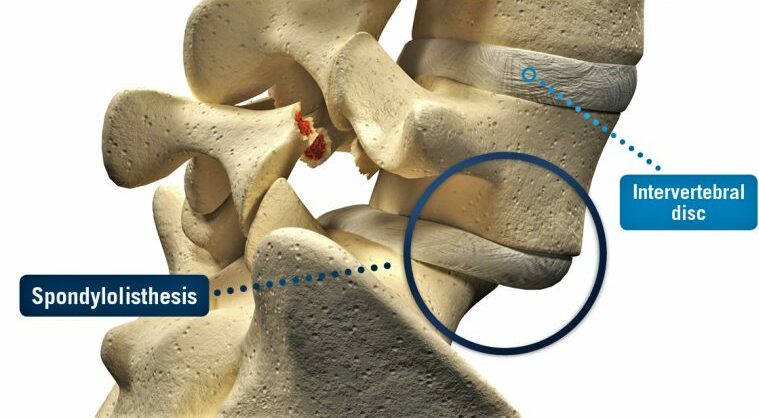Expert Spondylolisthesis Treatment in Vadodara
Stabilize spinal slippage, relieve chronic pain and restore function with specialized chiropractic care. Comprehensive non-surgical treatment for vertebral displacement and spinal instability.

Understanding Spondylolisthesis
Spondylolisthesis is a spinal condition where one vertebra slips forward over the vertebra below it
What is Spondylolisthesis?
Spondylolisthesis occurs when one spinal vertebra shifts out of its normal position, sliding forward over the vertebra beneath it. This condition most commonly affects the lumbar spine (L4-L5 or L5-S1 levels) and can cause significant pain, nerve compression, and functional limitations.
Grading System for Spondylolisthesis:
- Grade 1 - 0-25% vertebral slippage (mild)
- Grade 2 - 26-50% vertebral slippage (moderate)
- Grade 3 - 51-75% vertebral slippage (severe)
- Grade 4 - 76-100% vertebral slippage (very severe)
- Grade 5 - Complete displacement (spondyloptosis)
Common Types and Causes:
- Isthmic Spondylolisthesis - Caused by spondylolysis (stress fracture in pars interarticularis), common in athletes
- Degenerative Spondylolisthesis - Age-related wear and tear causing facet joint instability
- Congenital/Dysplastic - Born with spinal abnormalities that predispose to slippage
- Traumatic - Resulting from acute spinal injuries or fractures
- Pathological - Caused by bone diseases like osteoporosis or tumors
Early diagnosis and proper conservative management can often prevent progression and avoid the need for surgical intervention.

Spondylolisthesis Grading System
Understanding the severity helps determine appropriate treatment approaches
Grade 1 (Mild)
0-25% slippage
Minimal symptoms, often responsive to conservative care. Excellent prognosis with proper treatment.
Grade 2 (Moderate)
26-50% slippage
More significant symptoms, requires comprehensive conservative management. Good prognosis with dedicated care.
Grade 3 (Severe)
51-75% slippage
Significant symptoms, may require more intensive care. Conservative management still possible in many cases.
Grade 4-5 (Very Severe)
76-100% slippage
Often requires surgical consultation. Conservative care may help manage symptoms in selected cases.
Recognizing Spondylolisthesis Symptoms
Symptoms vary based on the degree of slippage and nerve involvement
Lower Back Pain
Localized pain in the lower back that may worsen with standing, walking, or extension movements. Often described as a deep ache.
Leg Pain & Sciatica
Radiating pain, numbness, or tingling down the legs due to nerve compression. May follow specific nerve root patterns.
Muscle Tightness & Spasms
Hamstring tightness and muscle spasms in the lower back as protective mechanisms to stabilize the unstable segment.
Neurological Symptoms
Leg weakness, foot drop, or changes in bowel/bladder function in severe cases with significant nerve compression.
Conservative vs Surgical Management
Understanding when conservative care is appropriate and when surgical consultation may be needed
Conservative Care Candidates
- Grades 1-2 spondylolisthesis
- Stable slippage without progression
- Mild to moderate symptoms
- No significant neurological deficits
- Good response to initial treatment
~80% of spondylolisthesis cases can be managed conservatively
Surgical Consultation Considered
- Grades 3-5 spondylolisthesis
- Progressive slippage on imaging
- Severe pain unresponsive to conservative care
- Significant neurological deficits
- Bowel or bladder function changes
Conservative care may still help manage symptoms while awaiting surgery
Most patients with spondylolisthesis can achieve significant improvement through comprehensive conservative management
Our Spondylolisthesis Treatment Approach
Comprehensive conservative care to stabilize the spine and relieve symptoms
Comprehensive Assessment

Spinal Stability Evaluation
Detailed assessment of spinal mobility, stability tests, and identification of compensatory movement patterns that may worsen the condition.

Neurological Examination
Comprehensive neurological testing including reflex assessment, muscle strength testing, and sensory evaluation to identify nerve involvement.

Imaging Analysis
Detailed review of X-rays, MRI, or CT scans to assess the degree of slippage, identify spondylolysis, and evaluate spinal canal compromise.
Our Conservative Treatment Methods

Stabilization-Focused Adjustments
Gentle, specific chiropractic techniques that avoid extension and focus on improving spinal stability without aggravating the slippage.

Non-Surgical Decompression
Targeted traction therapy to create space between vertebrae, reduce nerve compression, and facilitate healing without stressing the unstable segment.

Myofascial Release
Advanced soft tissue techniques to release tight hamstrings, hip flexors, and paraspinal muscles that contribute to spinal instability.

Core Stabilization Program
Progressive exercises focusing on deep core strengthening, particularly transverse abdominis and multifidus, to create a natural "internal brace."

Movement Re-education
Training in proper body mechanics, avoiding extension-based movements, and learning spine-sparing techniques for daily activities.

Activity Modification Guidance
Comprehensive recommendations for modifying sports, work activities, and daily routines to protect the unstable spinal segment during healing.
Patient Success Story
Real results from our spondylolisthesis management program
"I was diagnosed with Grade 2 spondylolisthesis after years of gymnastics in my youth. The constant lower back pain and leg numbness made even simple activities difficult. Multiple doctors recommended surgery, but I wanted to explore conservative options first. At Spine-X Clinic, Dr. Chandresh developed a comprehensive stabilization program that completely changed my prognosis. Through specific core strengthening, gentle adjustments that avoided extension, and learning proper movement patterns, my pain reduced by 90% within three months. Follow-up X-rays showed my slippage had stabilized, and I've been able to return to an active lifestyle without surgery. The educated approach to managing this complex condition made all the difference."
- 28-year-old former athlete from Vadodara (Spondylolisthesis Management Success)
Activity Guidelines for Spondylolisthesis
Understanding which activities to modify and which are beneficial
Avoid or Modify
- Heavy weight lifting
- Contact sports
- Gymnastics & dance
- Football & rugby
- Hyperextension exercises
Generally Safe
- Walking & hiking
- Swimming & water therapy
- Stationary cycling
- Yoga (modified)
- Pilates (supervised)
Exercise Guidelines
- Focus on flexion-based exercises
- Avoid spinal extension
- Build core strength gradually
- Listen to pain signals
- Progress slowly
Long-term Management Strategies
Maintaining stability and preventing progression over time
Core Maintenance
Continue core stabilization exercises as a lifelong practice to maintain spinal support and prevent instability recurrence.
Regular Monitoring
Periodic check-ups and occasional imaging to monitor stability and catch any progression early.
Activity Awareness
Maintain awareness of movement patterns and avoid high-risk activities that could stress the unstable segment.
Weight Management
Maintain healthy body weight to reduce mechanical stress on the lumbar spine and unstable segment.
Ergonomic Optimization
Continue proper body mechanics in daily activities, work, and sleep to support spinal health.
Flare-up Management
Have a plan for managing occasional flare-ups, including knowing when to seek professional care.
Ready to Stabilize Your Spine?
Book your comprehensive spondylolisthesis assessment today and explore conservative management options
Conservative First Approach
Comprehensive chiropractic care focused on spinal stabilization, pain reduction, and functional improvement without surgery for appropriate candidates